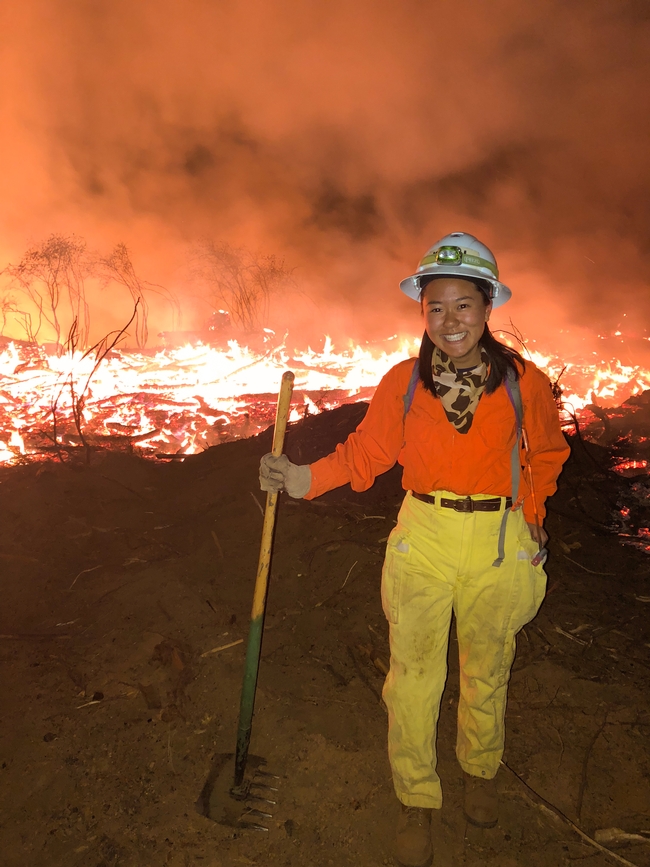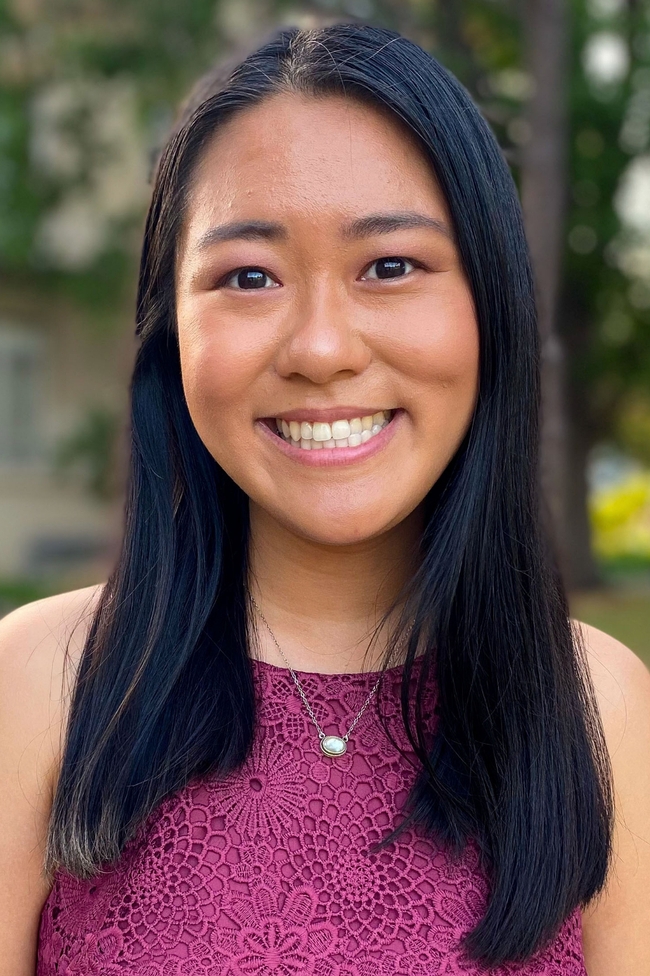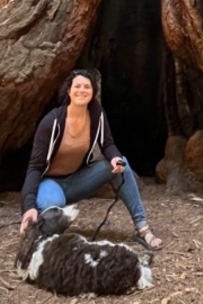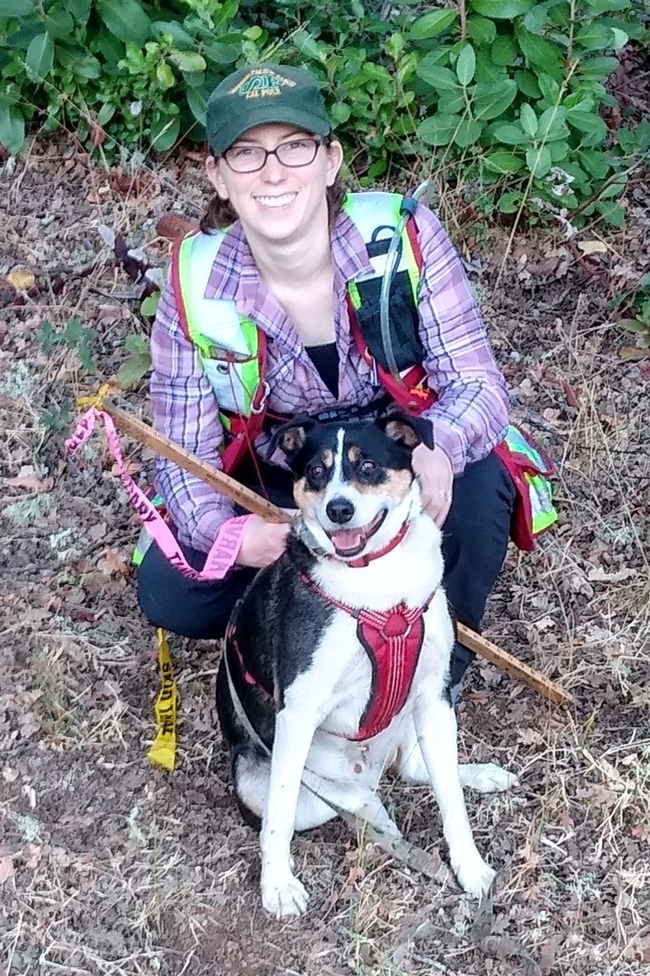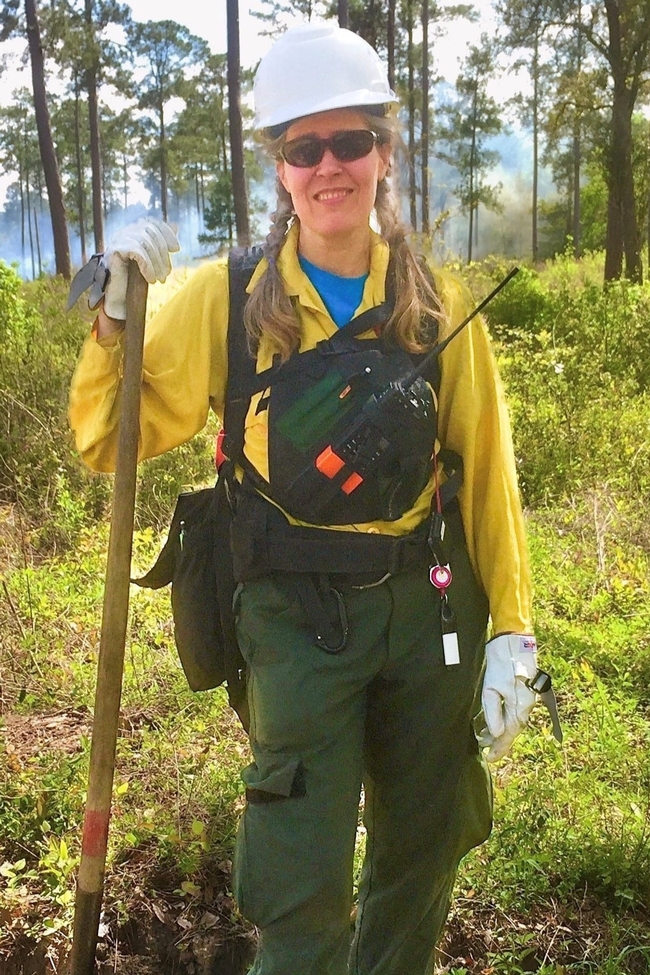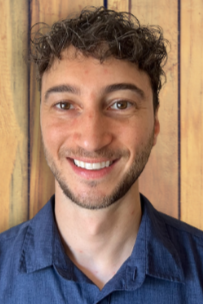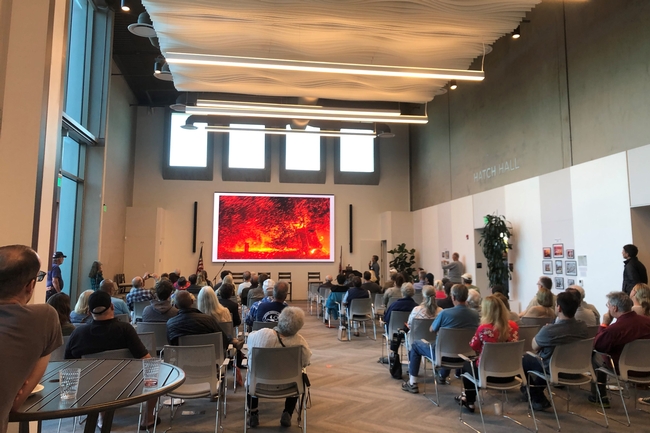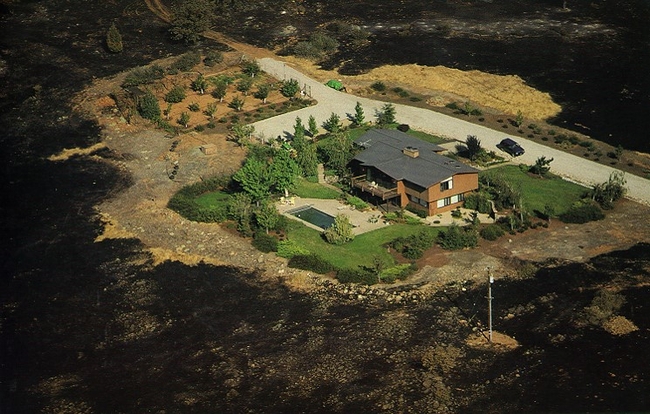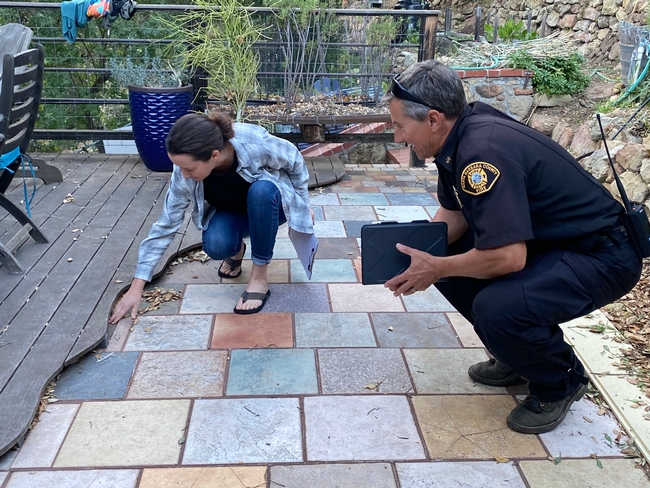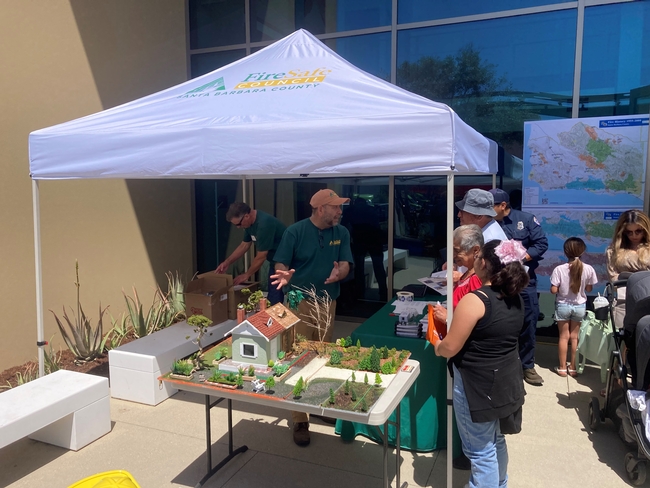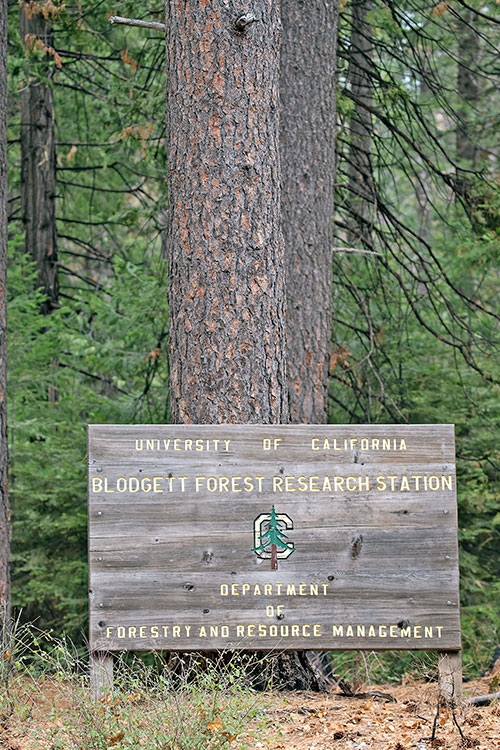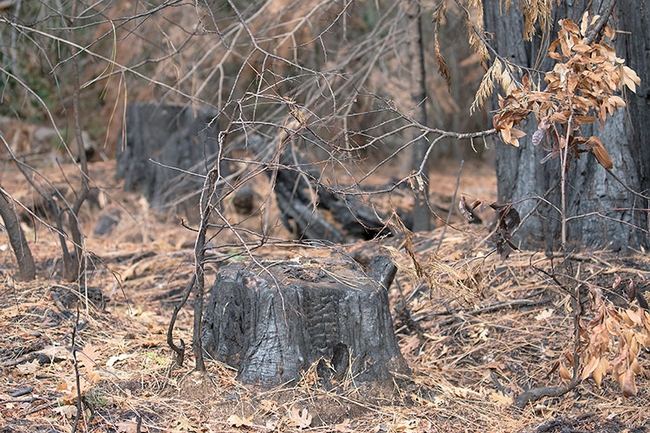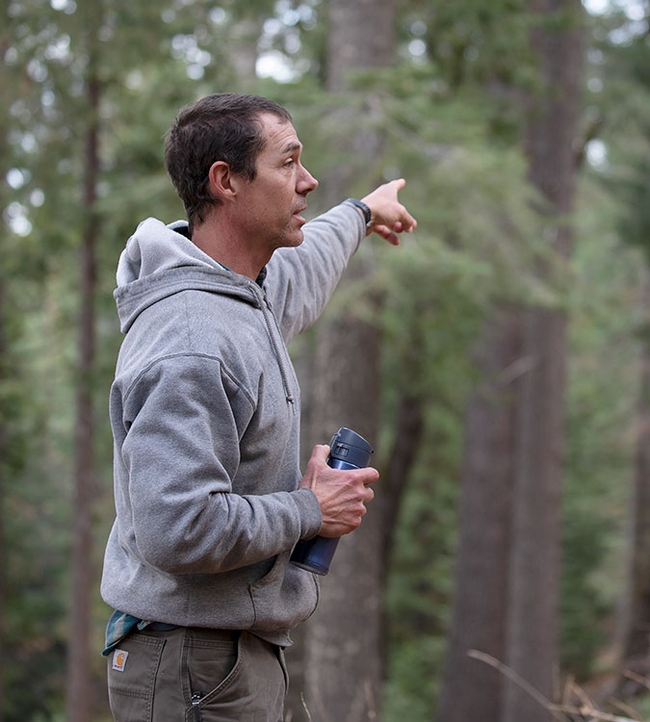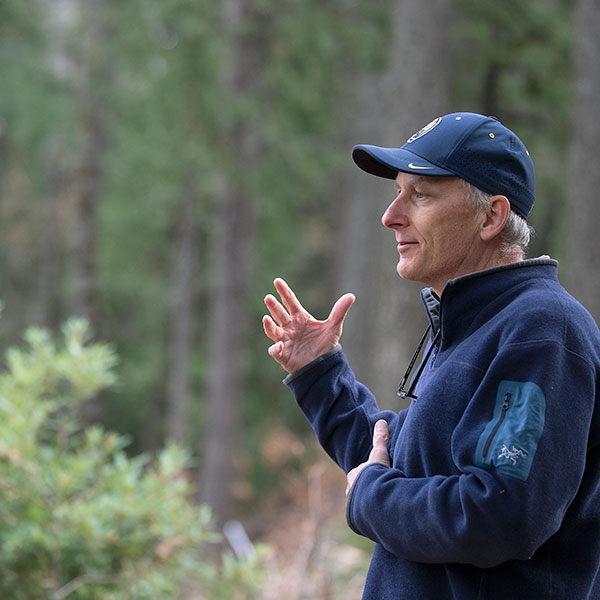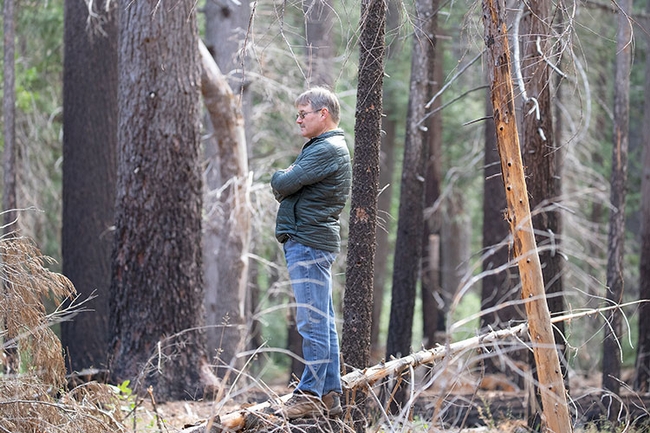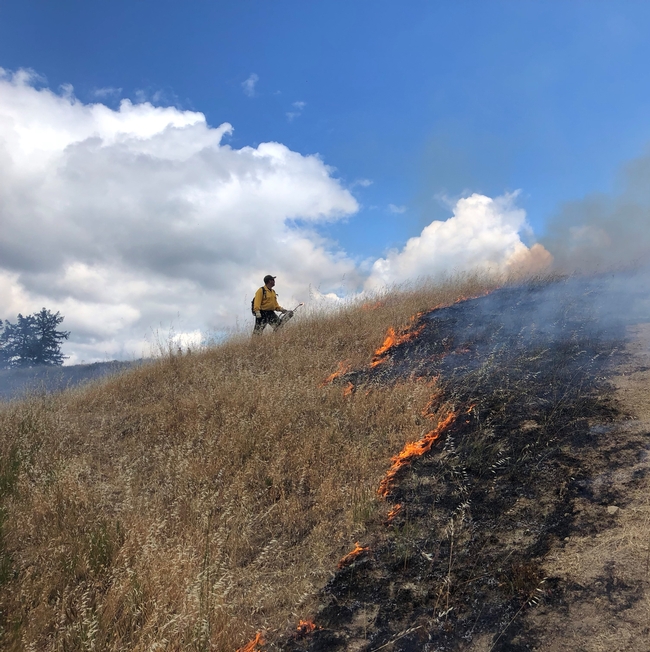Posts Tagged: fire
New advisors share crucial wildfire expertise
UC ANR hires more fire advisors to address growing threat to California communities
Bringing more expertise to more places across the state, University of California Agriculture and Natural Resources continues to hire fire advisors to help communities prepare for one of the most devastating climate-fueled threats.
With wildfires a constant danger as drought grips California, five highly skilled UC Cooperative Extension experts have joined the organization since early May:
- Katie Low, statewide fire coordinator (and also serving Nevada and Placer counties)
- Alison Deak, fire advisor serving Mariposa, Fresno and Madera counties
- Tori Norville, fire advisor serving Sonoma, Napa and Marin counties
- Barb Satink Wolfson, fire advisor serving Monterey, San Benito, Santa Clara and Santa Cruz counties
- Luca Carmignani, fire advisor serving Los Angeles and Orange counties
These positions – as well as other recent additions in agriculture and natural resources fields – are made possible by California's commitment, as reflected in the state budget, to improve the lives of residents in the face of a changing climate.
This robust team of fire experts provide broad knowledge and practical advice on a wide range of topics, including fire hazard mitigation, fire ecology, prescribed fire, wildland fire research, forest and wildlife management, and climate change effects.
Although their specific areas of expertise vary, all the new fire advisors are dedicated to helping residents and community groups across California become more fire-aware, adapted and resilient. They share vital information on how Californians can prepare homes, landscapes and property for wildfire.
Katie Low
Katie Low, who began as the University of California Cooperative Extension statewide fire coordinator on Sept. 1, will fulfill two important functions for UC Agriculture and Natural Resources' team of fire experts.
First, she will coordinate and partner with UCCE fire advisors throughout California to develop and deliver wildfire-related science and outreach materials for a wide range of communities across the state. Low said encouraging diversity in the network of fire experts and engaged communities will be crucial.
“One of my goals is to help build and maintain a diverse and inclusive community of fire and natural resource professionals,” she said.
Based at the UCCE office in Auburn, Low also will collaborate with local natural resource professionals and residents in Nevada and Placer counties on projects that bolster community and ecosystem resilience to wildfire and climate change.
“I look forward to working with community groups, land managers and scientists to implement viable fire-resilient management strategies for ecosystems in the region and statewide,” Low said.
Equipped with bachelor's degrees in geography and ecosystems management and forestry, as well as a master's in forestry, all from UC Berkeley, Low brings to UC ANR a wealth of knowledge and a variety of experience.
As a fire and forest ecologist, she studied the impacts of fuels-reduction and forest-restoration treatments on Sierra Nevada mixed-conifer forests. Low also worked as operations coordinator for the California Outdoor Engagement Coalition, and as a forestry aide for California Department of Forestry and Fire Protection's Forest Biometrics Program.
Low can be reached at 530-889-7385 and katlow@ucanr.edu; follow her on Twitter @lowseverityfire.
Alison Deak
Alison Deak joined UC Cooperative Extension in August 2022 as a fire advisor for Mariposa, Fresno and Madera counties. Since she began work, Deak has been focused on conducting a needs assessment and building rapport with community leaders.
Her role as fire advisor will include promoting the use of prescribed fire to help restore fire adapted landscapes. She will also prioritize community education, applied research and partnership building efforts that are based on scientifically informed ways to help communities mitigate, prepare for, and recover from wildfire.
Originally from northeast Ohio where there are no wildfires according to Deak, it was not until she moved to Colorado for college that she learned of their impact.
When the 2012 Waldo Canyon Fire occurred, Deak felt like her playground was burning down so she acted. She began volunteering with the wildfire recovery effort and her career into fire science took off from there.
Deak earned a bachelor's in geography and environmental studies from the University of Colorado in Colorado Springs and master's degrees in geography and nonprofit management from the University of Oregon.
Before moving to California and joining UC ANR, Deak worked as a wildland firefighter with the United States Forest Service and Bureau of Land Management.
When asked what she is looking forward to most, Deak shared that she is passionate about increasing diversity in the fire science field and, particularly, empowering more women to join. She is eager to help community members prepare for wildfire and mitigate fire risk in a safe and competent manner.
Deak is located at the UC Cooperative Extension office in Mariposa County and can be reached at aldeak@ucanr.edu.
Tori Norville
Tori Norville started on Aug. 1 as the new UC Cooperative Extension fire advisor for Sonoma, Napa and Marin counties.
In this capacity, Norville will work with residents and organizations within the wildland-urban interface to encourage and cultivate fire-adapted communities. She aims to provide education and outreach on home hardening, defensible space and the importance of forest and fuel management on the landscape.
While pursuing her bachelor's degree in forestry and natural resources at Cal Poly San Luis Obispo, Norville became interested in “disturbance ecology” – how factors such as disease, insects and fire affect landscapes and environments.
“Many of the forest health problems we are seeing are stemming from a lack of disturbance, which traditionally was fire,” Norville said.
Her understanding of fire and its effects deepened during her master's degree studies in forestry science (also at Cal Poly SLO), as well as through her seven years with CAL FIRE at the Jackson Demonstration State Forest in Mendocino County. She worked as the Registered Professional Forester for its Timber Sales Program, and then the Research and Demonstration Program.
Norville's firsthand experiences from the past few fire seasons have helped shape her goals and approach. She hopes to “work holistically with disturbances” – specifically fire – on the landscape to foster healthy forests and ecosystems that are adaptable and resilient, while also researching the environmental and social aspects of fuel-reduction projects and prescribed fire.
“Hopefully, I can begin to change the perception of fire from something we need to fear, to something we respect,” she said.
Norville, based at the UCCE office in Santa Rosa in Sonoma County, can be reached at trnorville@ucanr.edu.
Barb Satink Wolfson
Barb Satink Wolfson began in her role as UC Cooperative Extension fire advisor for Monterey, San Benito, Santa Clara and Santa Cruz counties on June 30.
Her primary responsibilities include wildland fire-related research and outreach for the Central Coast region, while building trust, strong partnerships and collaborative relationships within both professional and non-professional communities.
Satink Wolfson earned her B.S. and M.S. in forestry from Northern Arizona University, and brings to UC ANR more than 20 years of fire-research and outreach experience in Arizona. Her favorite job, though, was working as a backcountry ranger in Yosemite National Park during her undergraduate years.
In her new role, Satink Wolfson hopes to address some of the questions behind the use of prescribed fire in a variety of ecosystems (such as coastal prairies and oak woodlands), and help all Central Coast communities build resilience to wildland fire so residents can live safely within fire-adapted landscapes.
Satink Wolfson, based at the UCCE office in Hollister, can be reached at bsatinkwolfson@ucanr.edu.
Luca Carmignani
Luca Carmignani joined UCCE as a fire advisor for Orange and Los Angeles counties May 2. His research interests include image analysis, computer programming and scientific outreach.
Prior to joining UC ANR, Carmignani was a postdoctoral researcher in the Berkeley Fire Research Lab at UC Berkeley. His research has focused on fire and combustion applications, from wildland fires to material flammability.
He earned his Ph.D. in engineering sciences from the joint doctoral program between UC San Diego and San Diego State University after obtaining his bachelor's and master's degrees in aerospace engineering from the University of Pisa in Italy.
Carmignani is based at South Coast Research and Extension Center in Irvine and can be reached at carmignani@ucanr.edu and (949) 237-2956. Follow him on Twitter @l_carmignani.
Study: Regional approach to wildfire more comprehensive, equitable
Pilot program in Santa Barbara County shows promise for bolstering resilience
After a rash of wildfires across Southern California in 2003, many counties, cities and neighborhoods adopted Community Wildfire Protection Plans to improve their preparedness and fire response. But Rob Hazard, fire marshal for Santa Barbara County, has noticed that CWPPs and resources are unevenly distributed across areas at high risk of wildfire.
“Communities that are more affluent, more white, they are the ones that end up getting the grants, they're the ones that end up getting the projects to mitigate risks,” Hazard said, “whereas more disadvantaged communities…often don't have the organization to make that happen, or maybe it's not the most pressing issue of the moment.”
Mapping those underserved communities – and ensuring they have a more equitable share of attention – are some of the goals of a new, more comprehensive approach to wildfire, currently being piloted in Santa Barbara County. This “Regional Wildfire Mitigation Program” aims to fill in many of the gaps left by CWPPs, which tend to have a more narrow focus on fuel reductions for a specific locality.
“They certainly have their role and benefits, but CWPPs are pretty limited in scope,” said Max Moritz, University of California Cooperative Extension's statewide wildfire specialist. “They're really focused on modeling and prioritizing fuel breaks, and they leave all of these other aspects of our fire problem – our vulnerabilities, our potential losses – unaddressed.”
Moritz is the lead author of a recently published research article that describes the Regional Wildfire Mitigation Program's three key areas (or “domains”) for wildfire mitigation work: the built environment (pinpointing and addressing needs in buildings/infrastructure), landscape (creating buffers through land use policies and management choices), and community (educating the public on home hardening and other issues).
“It's this holistic approach that combines all of these elements, and each one of those elements speak to each other – they can't be independent,” said Hazard, a study co-author.
Seeking a better way
After the Thomas Fire devastated the region in 2017-18 and triggered deadly mudslides in Montecito, Moritz – an adjunct professor at UC Santa Barbara's Bren School of Environmental Science & Management – sought more encompassing risk mapping and mitigation solutions that could complement CWPP efforts.
He got together with Hazard, who began his career as a “hotshot crew” firefighter with the U.S. Forest Service and has been with Santa Barbara County Fire Department for nearly 25 years.
“Both of us believe: Yes, it is home hardening – but it's also defensible space, but it's also some fuel treatments, but it's also some prescribed fire, but it's also some agricultural belt (to create a buffer),” said Hazard. “We looked at it objectively, and in every community in Santa Barbara County there's something that either works – or doesn't.”
By the end of the pilot program along the south coast of Santa Barbara County, the team hopes to have refined a “decision support system” that other communities across the state – and perhaps around the globe – could use. The framework would incorporate their localized risk assessment data and conditions to help generate lists of prioritized projects across the three “domains” of wildfire mitigation.
The ability to adapt to new data and continual changes in ecosystems, communities and climate is another advantage of the RWMP. Unlike a “plan” that tends to be a one-off with a defined start and end date, this wildfire mitigation “program” is designed to pivot and evolve as conditions change. The goal is to motivate and guide implementation of risk mitigation activities in each domain.
“The program is a living program, so it's not going to be some PDF that sits on a server somewhere,” Hazard said.
One of the early lessons from the RWMP pilot has been that – aside from funding – a crucial factor in maintaining the momentum of a wildfire mitigation program is the presence of a dedicated group of community members.
“In each community, we'll need a group that is ready to take this on and spearhead it and run with it,” Moritz said. “In many communities, that will probably be the Fire Safe Council.”
Building ‘Firewise' communities
Local Fire Safe Councils are “grassroots, community-led organizations that mobilize residents to protect their homes, communities and environments from catastrophic wildfire,” according to the California Fire Safe Council.
And while Moritz, Hazard and other experts serve on the volunteer Board of Directors for Santa Barbara County Fire Safe Council, they soon realized that they needed to hire staff to perform the “community domain” work of educating and reaching out to residents.
A $5 million grant from the National Fish and Wildlife Foundation for the RWMP project helped build the capacity of the council, which hired its first staff member, Anne-Marie Parkinson, last fall.
“A lot of people underestimate how important it is to have community activists or leaders who take on the role and responsibility of organizing people, being the point of contact, rallying people to do activities or work days,” said Parkinson, a graduate of UCSB's Bren School and a co-author of the RWMP study.
Parkinson has been working to get communities recognized by Firewise USA, a program of the National Fire Protection Association to organize residents in bolstering wildfire preparedness and reducing risk.
Although she has been encouraged by the awareness and activism among the community members she has met, Parkinson also hears from residents about the need for more resilient power and communications networks – concerns that could be better addressed by consolidating those requests with a regional approach.
“As we work with more and more communities, you can start to map which communities want better telecommunications, and which communities would benefit from a fuel break around them, and then we could write a grant that benefits five communities, instead of one small grant for one community,” Parkinson said.
Moving forward
There are many communities in fire-prone environments that are in need of help, and climate change makes their situation increasingly urgent, Moritz said, and a new and comprehensive framework – the RWMP – now exists for assessing and mitigating multiple risks.
“Every community has its own unique fire hazards and its own unique spatial layout of neighborhoods and vulnerabilities inherent to those neighborhoods,” he said. “But despite the uniqueness of each community and each region, I'm hoping this will provide a somewhat systematic way to approach making progress and mitigating a whole suite of risks.”
Other authors of the article are Kelly Johnston, Molly Mowery and Katie Oran of the Community Wildfire Planning Center; Marc Mayes of Spatial Informatics Group-Natural Assets Lab and UC Santa Barbara Earth Research Institute; Graham Wesolowski of Spatial Informatics Group-Natural Assets Lab; and David Schmidt of Spatial Informatics Group. The article is published in Frontiers in Forests and Global Change at https://www.frontiersin.org/articles/10.3389/ffgc.2022.848254/full.
People interested in learning more about the RWMP approach are encouraged to contact Graham Wesolowski at gwesolowski@sig-nal.org or Max Moritz at mmoritz@bren.ucsb.edu.
Lessons on wildfire resilience from a 4,000-acre forest lab
In his years managing California woodlands, Rob York has come up with a few quick and easy ways to gauge whether a forest is prepared for wildfire.
“The first question I like to ask is, ‘Can you run through the forest?'” York says.
York, an assistant cooperative extension specialist and adjunct associate professor of forestry at UC Berkeley, poses the question while standing in a grove of pine trees during a tour of Blodgett Forest Research Station, a 4,000-acre experimental forest in the northern Sierra Nevada. While fire suppression has allowed many of California's forests to grow thick and dense, this patch of forest is one you could actually run through: The area is punctuated by large trees spaced a few meters apart, separated by a smooth carpet of dried pine needles.
“The idea is, if it doesn't have a lot of buildup of surface fuel on the ground — sticks and logs — you should be able to run through it,” York adds. “Looking through this forest, I might have to jump over that log, but, generally, I could take a jog through it.”
For more than 50 years, York and other Berkeley forestry researchers have used Blodgett as a living laboratory to study how different land management treatments — including prescribed burning, restoration thinning and timber harvesting — can reduce the risk of severe wildfire and improve a forest's resilience to the impacts of climate change. In addition to research, Blodgett regularly hosts workshops to demonstrate different land management techniques to landowners.
After another year of record-breaking wildfires in California, the work at Blodgett is more critical than ever, and state and federal agencies are motivated to enact more effective forest management practices. In 2020, the state and the U.S. National Forest Service jointly committed to managing 1 million acres of California forests a year, and last month the Biden administration pledged billions in new federal funding to reduce wildfire risk in the state.
“[Blodgett] was really designed to eventually demonstrate land management alternatives and offer a glimpse into how they might look at bigger scales,” York said.
Experimenting with fire
Blodgett Forest is “pretty representative of millions of acres of Sierra mixed conifer forest,” said Ariel Roughton, a research stations manager at Berkeley Forests. After the majority of its trees were logged in the early 1900s, the forest was donated to Berkeley in the 1930s with the intent that it would be used to study sustainable timber production. Aside from a few old relics that survived early logging, the majority of the trees are regrowth and approximately 100 years old.
“Back then, people thought, ‘Why would you ever want to use fire for land management?' They wanted to grow trees, they want to grow timber. The idea of seeing black and char was literally off the scale,” said Scott Stephens, a professor of forest science and co-director of Berkeley Forests. “It's amazing that just a few decades ago, researchers didn't have the opportunity to do the work that Rob and Ariel and others are doing up here now.”
In the open, airy tract of forest that York could easily jog through, blackened scorch marks extend 10 to 15 feet up the trunk of each tree. Ecologists believe that before European colonization, these forests experienced fire once every 10 years or less, leading to open forest structures very similar to this one. Here, two years ago, Roughton, York and their colleagues conducted a prescribed burn to remove excess fuel from the ground and reduce the risk of wildfire.
“I think it's important to remember that nature hasn't taken its course without a lot of human intervention since the last glaciation, because there was strong Indigenous burning here,” said John Battles, a professor of forest ecology at Berkeley. “There has always been intense human stewardship of one sort or another.”
According to the researchers, it took 15 to 20 years of active management, followed by regular maintenance, to get the forest tract to this state. Over the years, they have worked to achieve the open forest structure by harvesting some of the bigger trees for timber, but leaving the largest behind. They have also used a machine called a masticator to chip up smaller trees and conducted regular prescribed burns.
While there are forest management strategies that can be effective on a shorter time scale, it usually takes at least a few separate treatments over the course of a few years to successfully restore a forest and reduce its wildfire risk, York explains.
“It can be a challenge to get to the forest structure that we want,” York says. “It takes a lot of time, and it takes a lot of investment.”
Climate change is also narrowing the annual windows of time when conditions are best for prescribed burning, limiting when and how often foresters can safely burn. Hot, dry conditions usually make prescribed burning too risky during the summer, while rain and snow in the winter can leave the forest too wet and damp for fire to burn. However, research at Blodgett is showing that, with the right management decisions, prescribed burning during the winter can be made more viable.
“Because of timber harvests that removed some of the canopy and subsequent treatments to remove the ladder fuel, we now have more light hitting the ground, and it dries out faster,” Roughton said. “We've gotten to the point out here where we're able to burn more easily because of our past management actions.”
Friends of the forest
While York likes to imagine running through the trees, Battles has a slightly different metric for evaluating the health of a forest.
“You need to be able to run through the woods,” Battles said. “But I also want to see all six of my friends as I do my run.”
Battles' friends are the six tree species that make up the Sierra mixed conifer forest: oak, ponderosa pine, sugar pine, white fir, Douglas fir and incense cedar. Fire suppression — and the dense, overgrown forest structures that can result — often favor the survival of some of these species over others, leading to forests that are dominated by just one or two species. This lack of biodiversity can make the forest, as a whole, less resilient to stressors like bark beetles or tree pathogens, which often target some of these species, but not others.
According to Battles, the open structure and frequent fire at this tract of Blodgett has allowed all six of his friends to flourish.
“I see my friend, ponderosa pine, which you don't see as frequently in the unburned forest because it's shade intolerant — it needs light. I see oak, and it also requires fire to get a lot of the oaks,” Battles said. “I see all six of my friends all here, and you only see them when you have management like this.”
Over the past 20 years, research has shown that prescribed burning and mechanical thinning with tools like the masticator can also benefit soil quality and water availability, while having no significantly negative impacts on forest ecosystems. While burning or otherwise removing plants and trees can release carbon dioxide into the atmosphere, which accelerates the impacts of climate change, reducing the risk of severe wildfire can help maintain the whole forest for long-term carbon storage.
However, applying these techniques across 33 million acres of California forestland remains a monumental task. Prescribed burning requires a great deal of expertise and is also limited by weather conditions and air quality regulations. Meanwhile, mechanical tree thinning can be costly, and unlike timber harvesting, it does not generate any revenue for landowners — though Berkeley researchers have suggested that creating a market for small trees and other woody biomass could help offset the cost while limiting carbon emissions.
“Fire used to be so common in this system, and that's no different than in most forests in California. But, when you take it out for that long, you begin this transformation,” Stephens said. “That's why we have to get both public and private entities together to come up with a philosophy to be able to move forward on this. Blodgett is 4,000 acres — that's interesting, but it doesn't really address the needs of the state. We always hope that our work shows people what's possible and then enables them to continue it.”
California Dogface Butterfly: What the Fire Did
You've probably seen California's state insect, the California dogface butterfly, on a first-class stamp, in a book, or on the UC Davis...
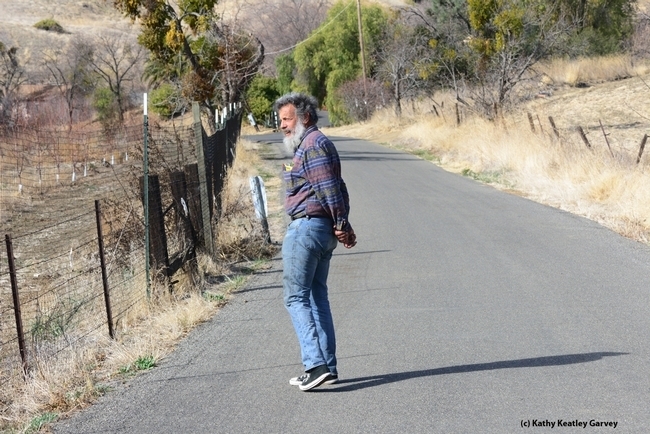
Butterfly guru Art Shapiro, UC Davis distinguished professor of evolution and ecology, walks up Gates Canyon in this image, taken in 2014. (Photo by Kathy Keatley Garvey)
First-ever California burn boss class meets in Eureka
New certification program will increase opportunities for prescribed fire across California
A group of 19 experienced prescribed burners are gathered in Eureka this week to become certified as prescribed fire burn bosses. The group is the first cohort to participate in the California State-Certified Burn Boss course, part of a certification program that was mandated by legislation in 2018, but was only recently finalized and approved. The course, hosted in Eureka by University of California Cooperative Extension, is a full week session and includes topics from laws, regulations, and permits to burn planning and smoke management.
"With each catastrophic wildfire season in California, the importance of prescribed fire becomes more clear," said Lenya Quinn-Davidson, University of California Cooperative Extension fire advisor, who is hosting the class in Eureka. "Prescribed fire is one of the most ecologically appropriate and cost-effective tools available, and provides innumerable benefits in California's fire-adapted landscapes. Prescribed burning is used to reduce fuels and wildfire risk, but also to restore habitat, control invasive species, improve rangelands, and promote cultural resources and values."
California is remarkably behind when it comes to implementing prescribed fire, she said. While states like Florida burn up to 2 million acres a year, California typically burns less than 100,000 acres statewide. It's clear that fire agencies can't meet the need for this work on their own — collaboration with local communities and leaders is essential.
The new program will certify prescribed fire practitioners who don't work for a fire management agency but are leading prescribed burning in their communities. This week's inaugural class in Eureka includes retired federally qualified burn bosses, tribal burn bosses, and leaders from state and local agencies and nonprofit organizations. Once certified by the state, these burn bosses will be able to share liability with CAL FIRE on prescribed burns.
“We've needed something like this in California for a long time, but never thought we'd see it happen. This is a historic moment for prescribed fire in California,” said Quinn-Davidson, who also leads the Northern California Prescribed Fire Council, and is currently being consulted for legislation that would break down even more barriers to prescribed fire.
In the last several years, more than a dozen community-based prescribed burn associations have developed throughout California. Many of these groups were inspired by the Humboldt County Prescribed Burn Association, which was the first of its kind in the western U.S. when it formed in 2018.
When these newly certified burn bosses leave Eureka, they will be able to go home and lift up efforts on their local landscapes, contributing to fire resilience across the state.


